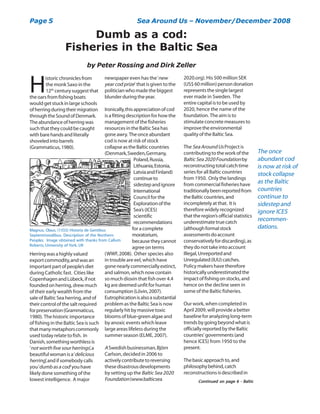
Dumb as a Cod - Sea Around Us Newsletter Dec 2008
- 1. Page 5 Sea Around Us – November/December 2008 Continued on page 6 - BalticContinued on page 6 - BalticContinued on page 6 - BalticContinued on page 6 - BalticContinued on page 6 - Baltic Dumb as a cod: Fisheries in the Baltic Sea by Peter Rossing and Dirk Zeller H istoricchroniclesfrom the monk Saxo in the 12th centurysuggestthat theoarsfromfishingboats would get stuck in large schools ofherringduringtheirmigration throughtheSoundofDenmark. Theabundanceofherringwas suchthattheycouldbecaught withbarehandsandliterally shoveledintobarrels (Grammaticus,1980). Herringwasahighlyvalued exportcommodity,andwasan importantpartofpeople’sdiet during Catholic fast. Cities like CopenhagenandLübeck,ifnot foundedonherring,drewmuch of their early wealth from the sale of Baltic Sea herring, and of their control of the salt required forpreservation(Grammaticus, 1980). The historic importance of fishing in the Baltic Sea is such thatmanymetaphorscommonly used today relate to fish. In Danish,somethingworthlessis ‘not worth five sour herrings’,a beautifulwomanisa‘delicious herring’,andifsomebodycalls you‘dumb as a cod’you have likely done something of the lowest intelligence. A major newspaper even has the‘new year cod prize’ that is given to the politicianwhomadethebiggest blunderduringtheyear. Ironically,thisappreciationofcod is a fitting description for how the management of the fisheries resources in the Baltic Sea has goneawry. Theonceabundant cod is now at risk of stock collapseastheBalticcountries (Denmark,Sweden,Germany, Poland,Russia, Lithuania,Estonia, LatviaandFinland) continueto sidestepandignore International Council for the Explorationofthe Sea’s (ICES) scientific recommendations for a complete moratorium, becausetheycannot agree on terms (WWF,2008). Other species also in trouble are eel, which have gonenearlycommerciallyextinct, andsalmon,whichnowcontain so much dioxin that fish over 4.4 kg are deemed unfit for human consumption(Lövin,2007). Eutrophicationisalsoasubstantial problem as the Baltic Sea is now regularlyhitbymassivetoxic bloomsofblue-greenalgaeand by anoxic events which leave large areas lifeless during the summer season (ELME, 2007). ASwedishbusinessman,Björn Carlson, decided in 2006 to activelycontributetoreversing thesedisastrousdevelopments by setting up the Baltic Sea 2020 Foundation(www.balticsea 2020.org). His 500 million SEK (US$60million)persondonation representsthesinglelargest ever made in Sweden. The entire capital is to be used by 2020, hence the name of the foundation. The aim is to stimulateconcretemeasuresto improvetheenvironmental qualityoftheBalticSea. The SeaAroundUs Project is contributingtotheworkofthe BalticSea2020Foundationby reconstructingtotalcatchtime series for all Baltic countries from 1950. Only the landings from commercial fisheries have traditionallybeenreportedfrom theBalticcountries,and incompletely atthat. Itis therefore widely recognized thattheregion’sofficialstatistics underestimatetruecatch (althoughformalstock assessmentsdoaccount conservativelyfordiscarding),as theydonottakeintoaccount Illegal,Unreportedand Unregulated(IUU)catches. Policy makers have therefore historicallyunderestimatedthe impactoffishingonstocks,and hence on the decline seen in some of the Baltic fisheries. Our work, when completed in April 2009, will provide a better baselineforanalyzinglong-term trendsbygoingbeyondwhatis officiallyreportedbytheBaltic countries’governments(and hence ICES) from 1950 to the present. Thebasicapproachto,and philosophybehind,catch reconstructionsisdescribedin The once abundant cod is now at risk of stock collapse as the Baltic countries continue to sidestep and ignore ICES recommen- dations.Magnus, Olaus. (1555) Historia de Gentibus Septentrionalibus. Description of the Northern Peoples. Image obtained with thanks from Callum Roberts, University of York, UK This article was published in the Sea Around Us newsletter Vol. 50.
- 2. Page 6Sea Around Us – November/December 2008 Baltic - Continued from page 5Baltic - Continued from page 5Baltic - Continued from page 5Baltic - Continued from page 5Baltic - Continued from page 5 Zeller et al. (2006; 2007). In essence, we utilize every data- andinformation-sourceavailable tous(includinggreyliterature, mediasourcesandexpert knowledge)toobtaindata ‘anchorpoints’intimeregarding nominalandIUUcatches (includingrecreational),aswell as discards. We have also endeavoredtoestablish collaborationswithlocalin- countryexpertsintheBaltic region,aslocalinput,knowledge andexperienceareparticularly valuableinhelpingusto developreasonabledatatime series. Therefore,Peter Rossing has been busy over the last 8 monthsestablishingand nurturing,relationshipswith scientistsintheBalticregionthat shareaninterestincollaborating with us. We have successfully establishedcollaborationsin Sweden,Finland,Germany, Russia,LithuaniaandLatvia,and have been able to get access to materialandsourcesfrom Poland. As a Dane, it has been a particularprivilegeforPeterto travelaroundtheBalticregion. Generally,ourrequestfor collaborationandadvicehas been well-received, as most people appreciate the relevance of what we are trying to achieve. Thegoodwillandinformation generated from these meetings andcollaborationscannotbe underestimated. However,asubstantialproblem hasbeenthepoliticalsensitivity overaccesstoexistingspatially disaggregateddiscardandillegal catchdata,despitethefactthat mostgovernmentinstitutionsin the Baltic and ICES have access tosuchdata.ICES,forexample, utilizessuchdiscarddatato improvetheiryearlystock assessmentsandfisheriesadvice totheEuropeanUnion. However,they are under considerablepoliticalpressure nottodisclosethecountry- specificdisaggregateddata,as Balticcountrygovernments wouldbeembarrassedif singled-outasamajorculpritof illegalactivities,orforwasting resourcesbythrowingdeadfish backintothesea. Peter found another example of how politics can interfere with the common good when he visitedtheInstituteforBalticSea FisheriesinRostock,Germany. Since2004,thisinstitutehas beenconductingextensive recreationalcatchsurveys.This apparentlybenignproject becameapoliticalhotpotato whentheresultsindicatedthat currentGermancodcatches would be 50% higher if recreational catches were included. Initially,theGerman governmentwantedtoclose down the project, however the resultshadalreadybeen published.Instead,theGerman governmentisnowpossibly facedwiththeuncomfortable situationofmakinganinformed decisionabouthowtodivide theirtotalcodquotabetween therecreationalandcommercial fishingsectors.Itisamazing, givensuchshenanigans,that there are still cod left in the Baltic.DumbCod! ReferencesReferencesReferencesReferencesReferences ELME.2007.BalticSea.pp.8-13 inLangmead,O.,Lowe,C., andMcQuatters-Gollop,A. (Eds).EuropeanLifestylesand MarineEcosystems- Exploringchallengesfor managing Europe’sseas. UniversityofPlymouth MarineInstitute,Plymouth, UK. Grammaticus,S.1980.The historyoftheDanes.D.S. Brewer,Woodbridge,Suffolk, UK, 528 p. ICES. 2007. Report of the Baltic FisheriesAssesmentWorking Group(WGBFAS).ICES Copenhagen, 1-750 p. Lövin,I.2007.Tyst hav - jakten på densistamatfisken.Ordfront, Stockholm,200p. WWF.2008.A sustainable future for Baltic Sea Cod and Cod fisheries.WWFBaltic Ecoregion programme 24 p. Zeller,D.,Booth,S.,Craig,P.and Pauly,D.2006. Reconstruction of coral reef fisheries catches in AmericanSamoa,1950- 2002. Coral Reefs 25: 144- 152. Zeller,D.,Booth,S.,Davis,G.and Pauly,D.2007.Re-estimation of small-scale fisheries catchesforU.S.flagisland areas in the Western Pacific: The last 50 years. Fisheries Bulletin 105: 266-277. There are approximately 100 fish species living in the Baltic Sea RegioncomprisingDenmark,Sweden,Germany,Poland,Russia, Lithuania,Estonia,LatviaandFinland.Thefishfaunainclude marine(e.g.,cod,flatfish,sprat,herring),anadromous(e.g., Atlanticsalmon,andSeatrout)catadromous(e.g.,Europeaneel) and fresh water species (e.g.,pike and perch).The diversity, compositionanddistributionoftheBalticfishfaunais influenced by the brackish-water and enclosed nature of the Baltic Sea.The number of marine species is therefore highest in areasneartheDanishStraitsanddiminisheseastwardsand northwardsassalinitydecreases.Thecatchesofcod,herring andsprathas,inrecenttimes,accountedforapproximately95% of the reported commercial catches in the Baltic (ICES, 2007). The Baltic Sea